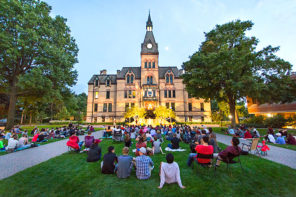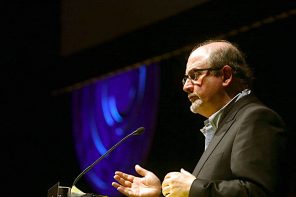The conflation between religion and politics is a problem for both scholars of religion and political scientists. We must constantly judge whether politicians are using religion instrumentally, to give themselves justification for particular actions. We must also judge whether religious leaders are using politics to acquire power over their followers. Of course, this problem originates from the belief that religion is an important component of civil society. From schools to hospitals to shelters, religious groups have always filled the gap when governments have failed. It is impossible for a religious person to stop being religious when it comes to politics. However, we also recognize that civic engagement means entering into a social contract where rights and obligations are married to responsibilities to civic society. This means, in part, that while we can be religious, we cannot impose our religious belief on others, just as others cannot impose their beliefs on us. We may come to a mutual agreement on the best course of action that align with religious belief, but that is different than imposing a religious edict.
Two current incidents show the perilous relationship between religion and politics and responsibilities in civil society:
The first case is based in the US and involves the ACLU. Several students in a Florida school district wore shirts that said “Islam is of the Devil.” They were sent home because their clothing was offensive. At least one student is suing, and the ACLUis representing the student. The ACLU is right. Schools have a right to set policy regarding clothing, and most public schools that I am aware of ban the seven words you cannot say on TV. This type of limitation is non-discriminatory and has been upheld in the judicial system. The banning of one type of shirt that does not possess any language prohibited by the school, seems to be a violation of the students’ free speech rights. The ACLU is right. General bans against inappropriate messages or hate speech are notoriously vague. Clear language about no clothing with text are much clearer. If faculty were concerned about the message, it should have been turned into a teaching moment. There is a great deal of religious illiteracy in this country, and the challenge is to make people more religiously literate, not pretend it does not exist. Conversations about the role of religion in community building, civil society, and even politics all strike me as better responses than sending ignorant children home uneducated. The best response to challenging speech is more speech. It is the marketplace of ideas that John Stuart Mill advocated for, and which is quickly becoming the bazaar we no longer enjoying trading in. My position on this matter is notunique. Many other American Muslims also advocate this position. We recognize it as our responsibility to defend free speech because it is also our right.
In Europe, the social contracts are more fraught with weaknesses, as witnessed by the recent Swiss vote to ban minarets. As Dan Varisco notes, the question should be “why minarets?” He says:
The minaret is, of course, a symbol, but a rather unusual choice. In one sense it is like saying that MacDonalds cannot have a high sign (as is the case in some municipalities) but they can serve all the hamburgers they want. Thus, this ban is not on building mosques, nor does it prevent Muslims from praying in mosques. Since minarets long ago ceased to have functional value, apart from perhaps holding a loud speaker, the minaret is indeed symbolic.
But why the minaret? I suspect that this is a very Christian response, not unlike the centuries old designation of Islam as Mohammedanism. Since Church steeples are so emblematic in Christianity, it must be assumed that the minaret holds a similar position for Muslims. There is nothing in the Quran or traditions that mandates a minaret; just as Jesus never told his followers to build steeples. A minaret is also a visible difference for a building that may look “Middle Eastern” but otherwise would not stand out as much. So the vote does not really prevent Muslims from worship, but it does send a message. This message is an Islamophobic domino theory response, since the real issue is not about architecture (or any misguided birds who may occasionally fly into a minaret) but about assimilation.
The minaret is very much a symbol. If one were to ask how to identify a mosque, I suspect most people would say either minaret or dome. The Prophet Muhammad’s mosque was simply his house, with no distinguishing external characteristics. Muslims can live without a minaret; in fact, there are only four minarets in all of Switzerland, so they are living without them. This move by politicians seems like a first salvo in terms of limiting the rights of a religious minority within its borders. Although worship is not curtailed, the discourse around the minaret focused on ritual practices and the clothing worn by Muslims. My suspicion is that if this law passes various legal challenges, the next step will be to determine what clothes the religious minority is allowed to wear in public, like in France, and registration of worship spaces.
Several commentators note that many of the Muslims in Switzerland are European, from Eastern Europe or Turkey, and therefore are phenotypically white, reducing the racial component in all of these debates. I am uncomfortable with this reasoning as it ignores the experience of racial categories of whiteness that we saw in the US, and which were prevalent in Europe. The Irish and the Italians were not considered “white” when they came to the US, and Slavs, or Eastern Europeans, were considered of lesser racial stock. In Europe, we see the racialization of a religious community when we consider Jews. The conflation between race and religion exists amongst descriptions of Muslims as well. In fact, I have argued elsewhere that the images of the “Jew” have simply been transferred to the “Muslim.”
What the vote in Switzerland shows is just how ill-at-ease the “home” of the Enlightenment is with the Enlightenment. Kieran Healy at Crooked Timber points out how absurd it is for the Swiss to be talking about women’s rights when they only granted women the right to vote in the latter part of the 20th century. The idea of incorporation of different groups and of freedom of religion works in theory, but seems to be difficult to implement. One can see the how challenging Enlightenment ideas are, when the refrain one hears is that there is no religious freedom in Saudi Arabia. Saudi Arabia is atrocious when it comes to matters of religious freedom. However, they do not claim to embrace the Enlightenment or difference. It does not seem to be a good idea to race to the bottom of the barrel when it comes to rights. Either rights are good thing or they are not. It should not be a matter of “rights are good thing, but if no one else is doing it, why should we?” Any good must be fought for and defended, not sacrificed out of fear and ignorance.
Tariq Ramadan, based in Switzerland, suggests his compatriots need to be more actively involved in politics, and more visible in the public sphere. While there is probably some value in that proposition, it also seems like too little too late. Yasir Qadhiasks Muslims living as minorities to question what it is they need as a community. In many respects, his approach is quite similar to Ramadan’s, including moving beyond the medieval stereotype of dar al-Islam (house of Islam) and dar al-harb(house of war), which has had not practical import for centuries. However, I do disagree with Qadhi that what Muslims are experiencing in the “West” is new. Many of these issues have come up in generalities, if not particularities, in the past. The Muslims of South Asia have to live as a minority, and in an interfaith environment. The Muslims of Indonesia are in an interfaith milieu. The Muslims of Eastern Europe had limitation on their buildings, and the Muslims in the former Soviet Union had limits on their worship. We have survived these issues and have developed, or are developing, a sophisticated theological response to many of the questions he raises. The problem is getting the word out to other Muslims and to non-Muslims.
The minaret is simply a symbol, but bodes a broader move against a racialized religious minority. Becoming more visible is one avenue, and the question is how to become more visible. Aziz Poonawalla argues for a confrontational architecture that reinvisions what it means to belong by constructing spaces that are both Muslim and Swiss. Since church steeples emerge out of the exposure to minarets, working on a new architectural style that will define Europe again should not be difficult. Poonawalla is also correct in noting that this will do nothing to prevent radicalization. Building minarets does not mean a more integrated population, but banning it guarantees further marginalization.
The rending of the social contract is not a good omen. Religion must be recognized as an important part of civil society. The tension between religious and political obligations must constantly be negotiated. Unfortunately, what the Swiss case shows is that it is easy to fall back into tribalism and to exclude people. Swiss Muslims should reinforce the point that this is a rights based issue. They should either challenge the ruling in court or, I think what would be a more powerful statement, is to let it go unchallenged. They should say, “you can have the minarets, they mean nothing. What we want are recognition of our rights to practice our faith without government interference, to have access to all the rights and responsibilities of other Swiss citizens, and avenues for political participation.” Swiss Muslims should take this as a teaching moment, and say minarets are meaningless, and those who voted for their ban know nothing about Islam, then launch an education campaign. If the right-wing Swiss parties want to tear the state apart, it should be Muslims who stand up to repair it.




